Analyzing Challenges and Stakeholders at RGIA Airport, Hyderabad
VerifiedAdded on 2023/01/19
|17
|3568
|53
Report
AI Summary
This report provides a detailed analysis of the management processes at Rajiv Gandhi International Airport (RGIA), Hyderabad, focusing on the challenges faced by the project head and the involvement of stakeholders. It examines key challenges such as system integration, supply chain management, and the implementation of innovative technologies. The report delves into leadership styles and how they are used to manage these challenges, including autocratic, democratic, and delegative approaches. A stakeholder analysis is conducted, highlighting the interests and involvement of various stakeholders, including regulatory authorities, local communities, and airport operators. The report also addresses the tensions and trade-offs in public-private partnerships, specifically the competition of interest between public and private stakeholders. It concludes with an assessment of the financial arrangements and sustainability of the airport, and identifies opportunities for improvement in areas such as infrastructure growth, business opportunities, and stakeholder engagement. The report is based on the context of the case study of the aviation industry, named as Rajiv Gandhi International Airport, Hyderabad and is based on the assignment brief provided.
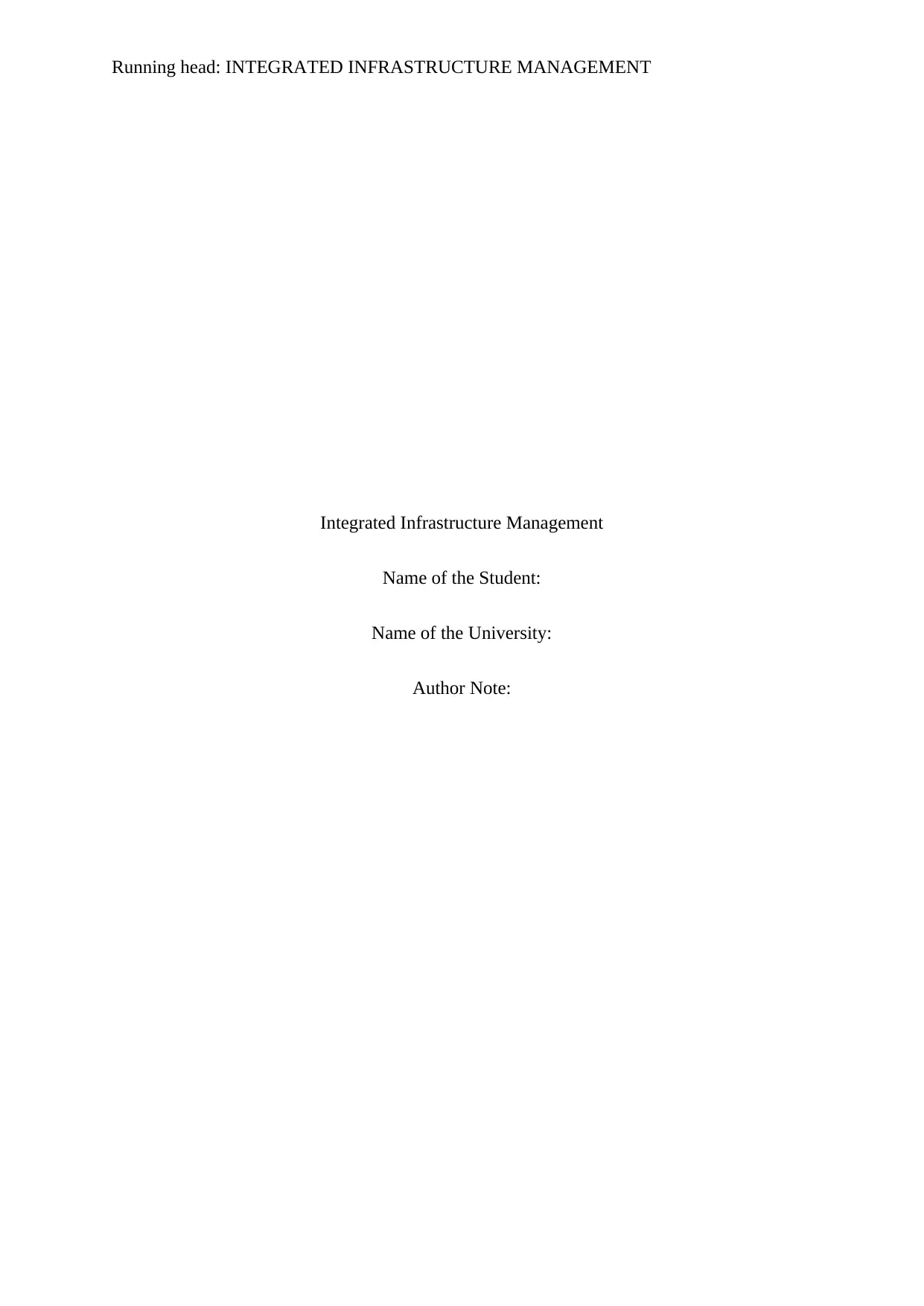
Running head: INTEGRATED INFRASTRUCTURE MANAGEMENT
Integrated Infrastructure Management
Name of the Student:
Name of the University:
Author Note:
Integrated Infrastructure Management
Name of the Student:
Name of the University:
Author Note:
Paraphrase This Document
Need a fresh take? Get an instant paraphrase of this document with our AI Paraphraser
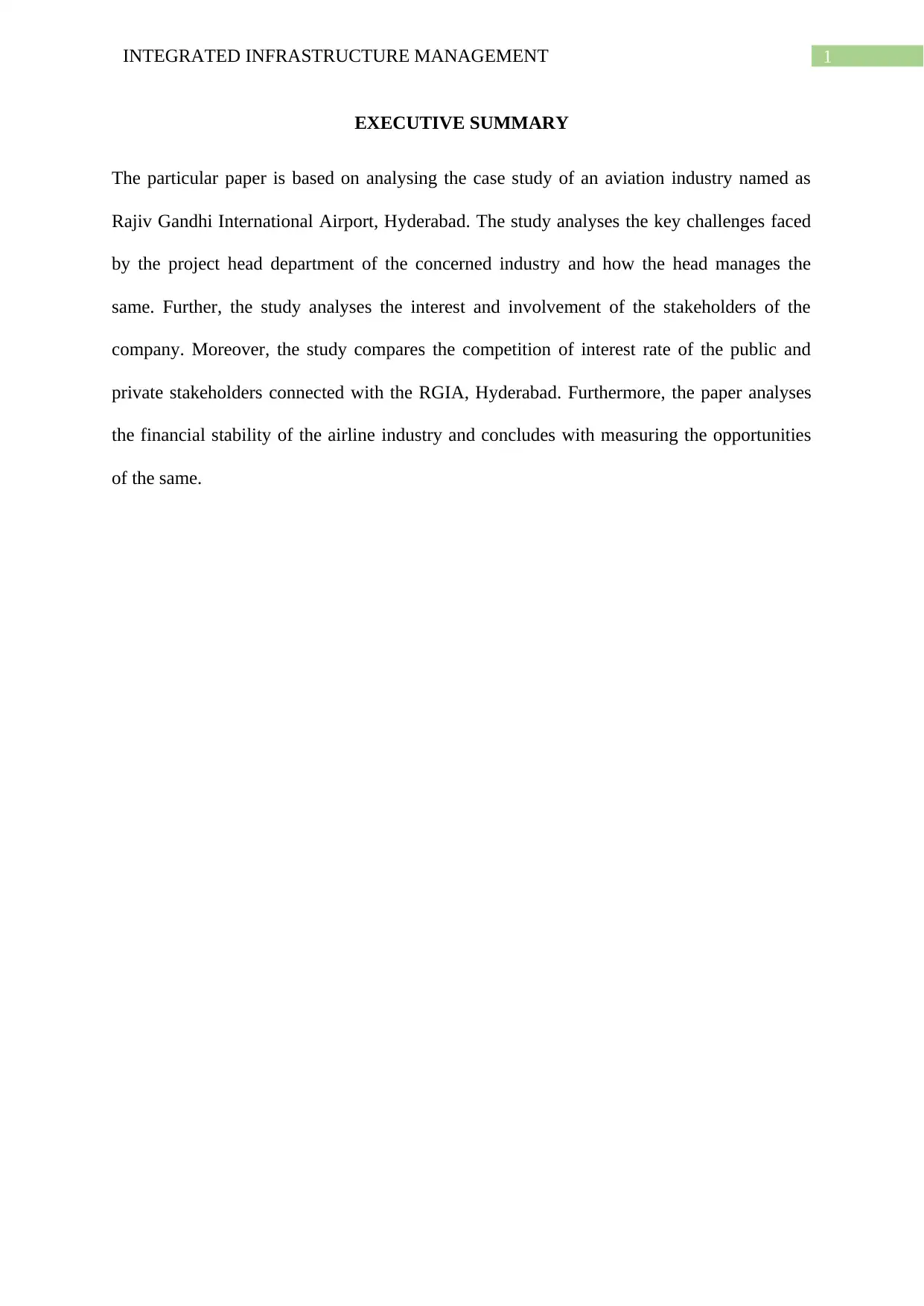
1INTEGRATED INFRASTRUCTURE MANAGEMENT
EXECUTIVE SUMMARY
The particular paper is based on analysing the case study of an aviation industry named as
Rajiv Gandhi International Airport, Hyderabad. The study analyses the key challenges faced
by the project head department of the concerned industry and how the head manages the
same. Further, the study analyses the interest and involvement of the stakeholders of the
company. Moreover, the study compares the competition of interest rate of the public and
private stakeholders connected with the RGIA, Hyderabad. Furthermore, the paper analyses
the financial stability of the airline industry and concludes with measuring the opportunities
of the same.
EXECUTIVE SUMMARY
The particular paper is based on analysing the case study of an aviation industry named as
Rajiv Gandhi International Airport, Hyderabad. The study analyses the key challenges faced
by the project head department of the concerned industry and how the head manages the
same. Further, the study analyses the interest and involvement of the stakeholders of the
company. Moreover, the study compares the competition of interest rate of the public and
private stakeholders connected with the RGIA, Hyderabad. Furthermore, the paper analyses
the financial stability of the airline industry and concludes with measuring the opportunities
of the same.
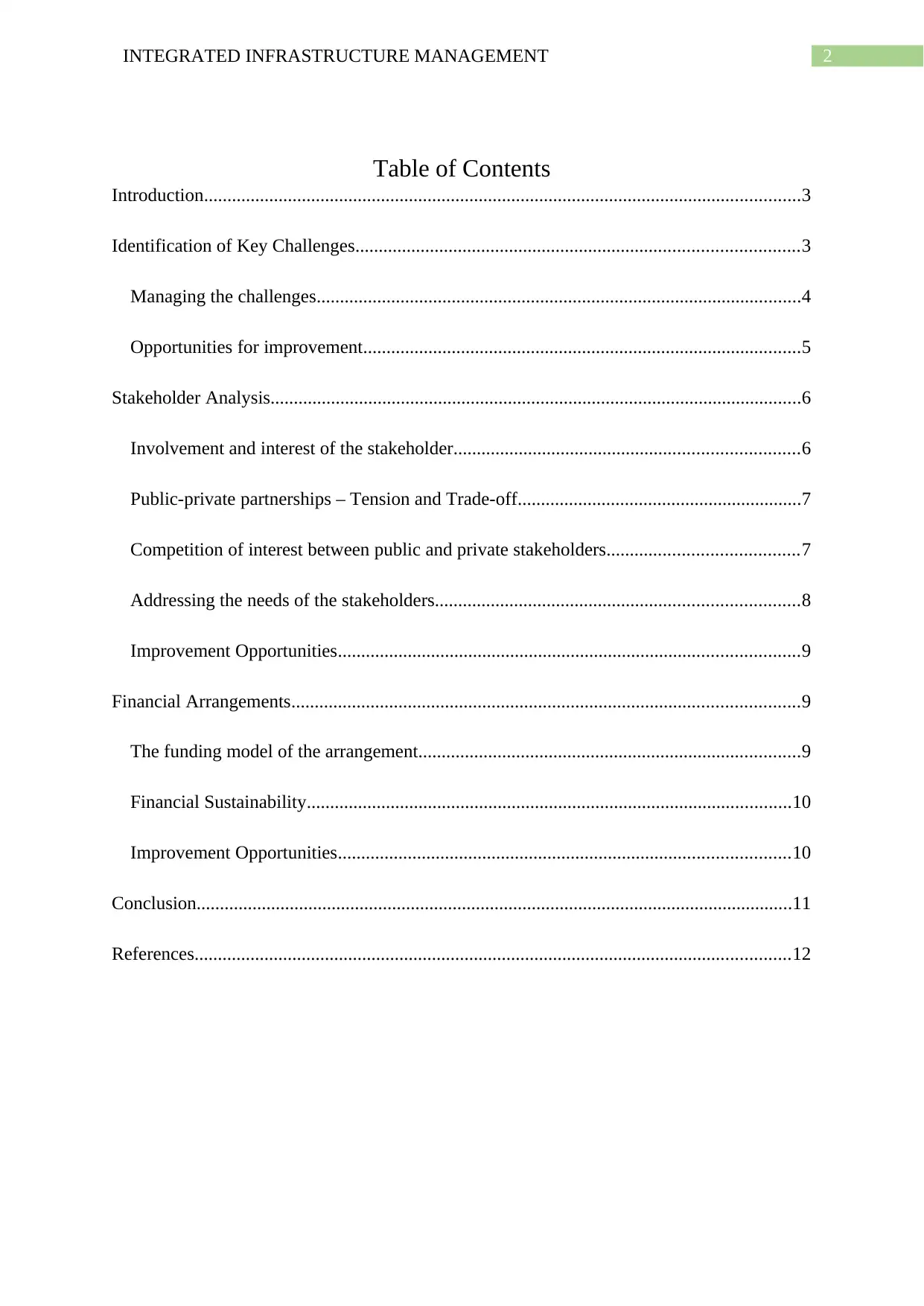
2INTEGRATED INFRASTRUCTURE MANAGEMENT
Table of Contents
Introduction................................................................................................................................3
Identification of Key Challenges...............................................................................................3
Managing the challenges........................................................................................................4
Opportunities for improvement..............................................................................................5
Stakeholder Analysis..................................................................................................................6
Involvement and interest of the stakeholder..........................................................................6
Public-private partnerships – Tension and Trade-off.............................................................7
Competition of interest between public and private stakeholders.........................................7
Addressing the needs of the stakeholders..............................................................................8
Improvement Opportunities...................................................................................................9
Financial Arrangements.............................................................................................................9
The funding model of the arrangement..................................................................................9
Financial Sustainability........................................................................................................10
Improvement Opportunities.................................................................................................10
Conclusion................................................................................................................................11
References................................................................................................................................12
Table of Contents
Introduction................................................................................................................................3
Identification of Key Challenges...............................................................................................3
Managing the challenges........................................................................................................4
Opportunities for improvement..............................................................................................5
Stakeholder Analysis..................................................................................................................6
Involvement and interest of the stakeholder..........................................................................6
Public-private partnerships – Tension and Trade-off.............................................................7
Competition of interest between public and private stakeholders.........................................7
Addressing the needs of the stakeholders..............................................................................8
Improvement Opportunities...................................................................................................9
Financial Arrangements.............................................................................................................9
The funding model of the arrangement..................................................................................9
Financial Sustainability........................................................................................................10
Improvement Opportunities.................................................................................................10
Conclusion................................................................................................................................11
References................................................................................................................................12
⊘ This is a preview!⊘
Do you want full access?
Subscribe today to unlock all pages.

Trusted by 1+ million students worldwide
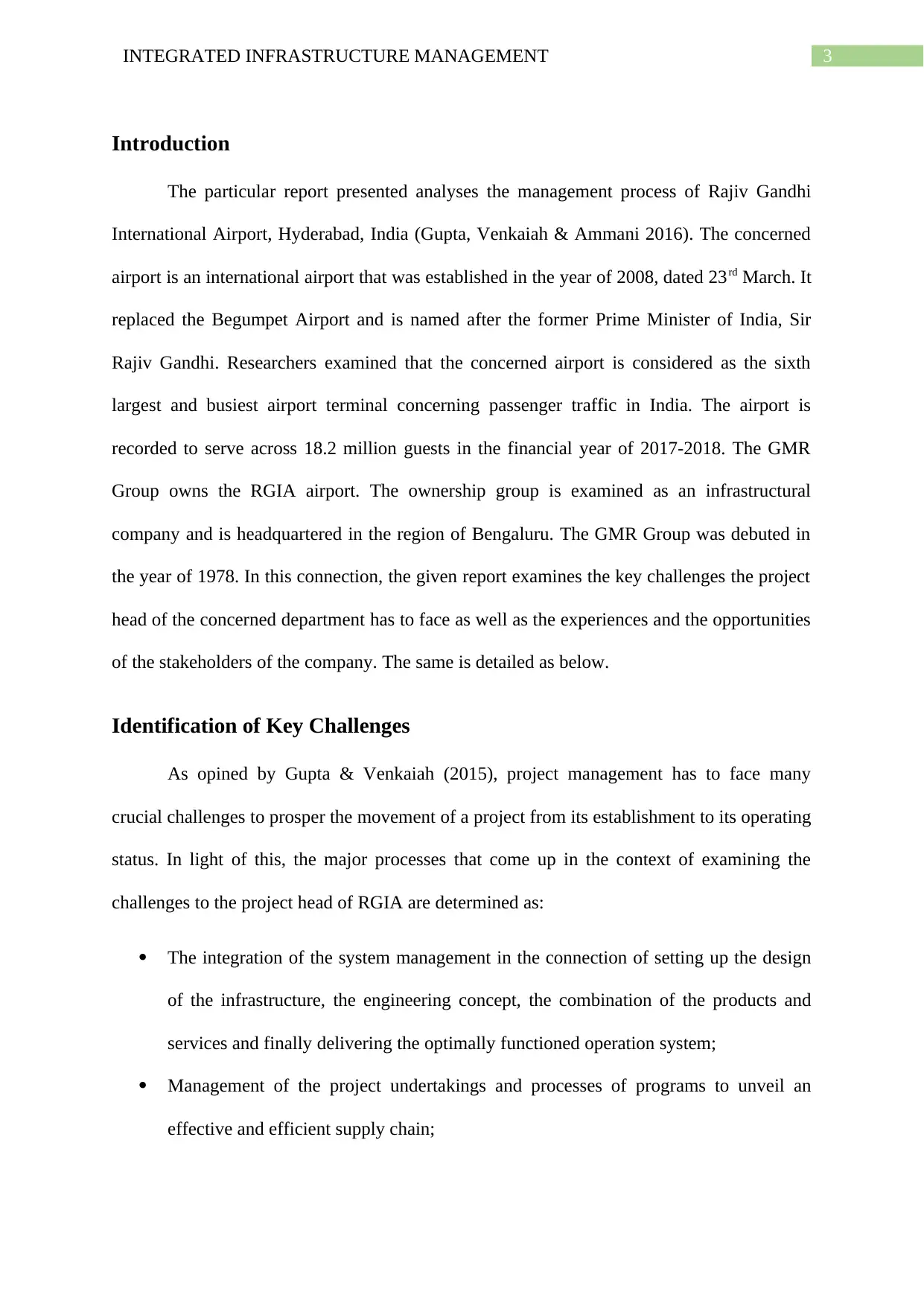
3INTEGRATED INFRASTRUCTURE MANAGEMENT
Introduction
The particular report presented analyses the management process of Rajiv Gandhi
International Airport, Hyderabad, India (Gupta, Venkaiah & Ammani 2016). The concerned
airport is an international airport that was established in the year of 2008, dated 23rd March. It
replaced the Begumpet Airport and is named after the former Prime Minister of India, Sir
Rajiv Gandhi. Researchers examined that the concerned airport is considered as the sixth
largest and busiest airport terminal concerning passenger traffic in India. The airport is
recorded to serve across 18.2 million guests in the financial year of 2017-2018. The GMR
Group owns the RGIA airport. The ownership group is examined as an infrastructural
company and is headquartered in the region of Bengaluru. The GMR Group was debuted in
the year of 1978. In this connection, the given report examines the key challenges the project
head of the concerned department has to face as well as the experiences and the opportunities
of the stakeholders of the company. The same is detailed as below.
Identification of Key Challenges
As opined by Gupta & Venkaiah (2015), project management has to face many
crucial challenges to prosper the movement of a project from its establishment to its operating
status. In light of this, the major processes that come up in the context of examining the
challenges to the project head of RGIA are determined as:
The integration of the system management in the connection of setting up the design
of the infrastructure, the engineering concept, the combination of the products and
services and finally delivering the optimally functioned operation system;
Management of the project undertakings and processes of programs to unveil an
effective and efficient supply chain;
Introduction
The particular report presented analyses the management process of Rajiv Gandhi
International Airport, Hyderabad, India (Gupta, Venkaiah & Ammani 2016). The concerned
airport is an international airport that was established in the year of 2008, dated 23rd March. It
replaced the Begumpet Airport and is named after the former Prime Minister of India, Sir
Rajiv Gandhi. Researchers examined that the concerned airport is considered as the sixth
largest and busiest airport terminal concerning passenger traffic in India. The airport is
recorded to serve across 18.2 million guests in the financial year of 2017-2018. The GMR
Group owns the RGIA airport. The ownership group is examined as an infrastructural
company and is headquartered in the region of Bengaluru. The GMR Group was debuted in
the year of 1978. In this connection, the given report examines the key challenges the project
head of the concerned department has to face as well as the experiences and the opportunities
of the stakeholders of the company. The same is detailed as below.
Identification of Key Challenges
As opined by Gupta & Venkaiah (2015), project management has to face many
crucial challenges to prosper the movement of a project from its establishment to its operating
status. In light of this, the major processes that come up in the context of examining the
challenges to the project head of RGIA are determined as:
The integration of the system management in the connection of setting up the design
of the infrastructure, the engineering concept, the combination of the products and
services and finally delivering the optimally functioned operation system;
Management of the project undertakings and processes of programs to unveil an
effective and efficient supply chain;
Paraphrase This Document
Need a fresh take? Get an instant paraphrase of this document with our AI Paraphraser
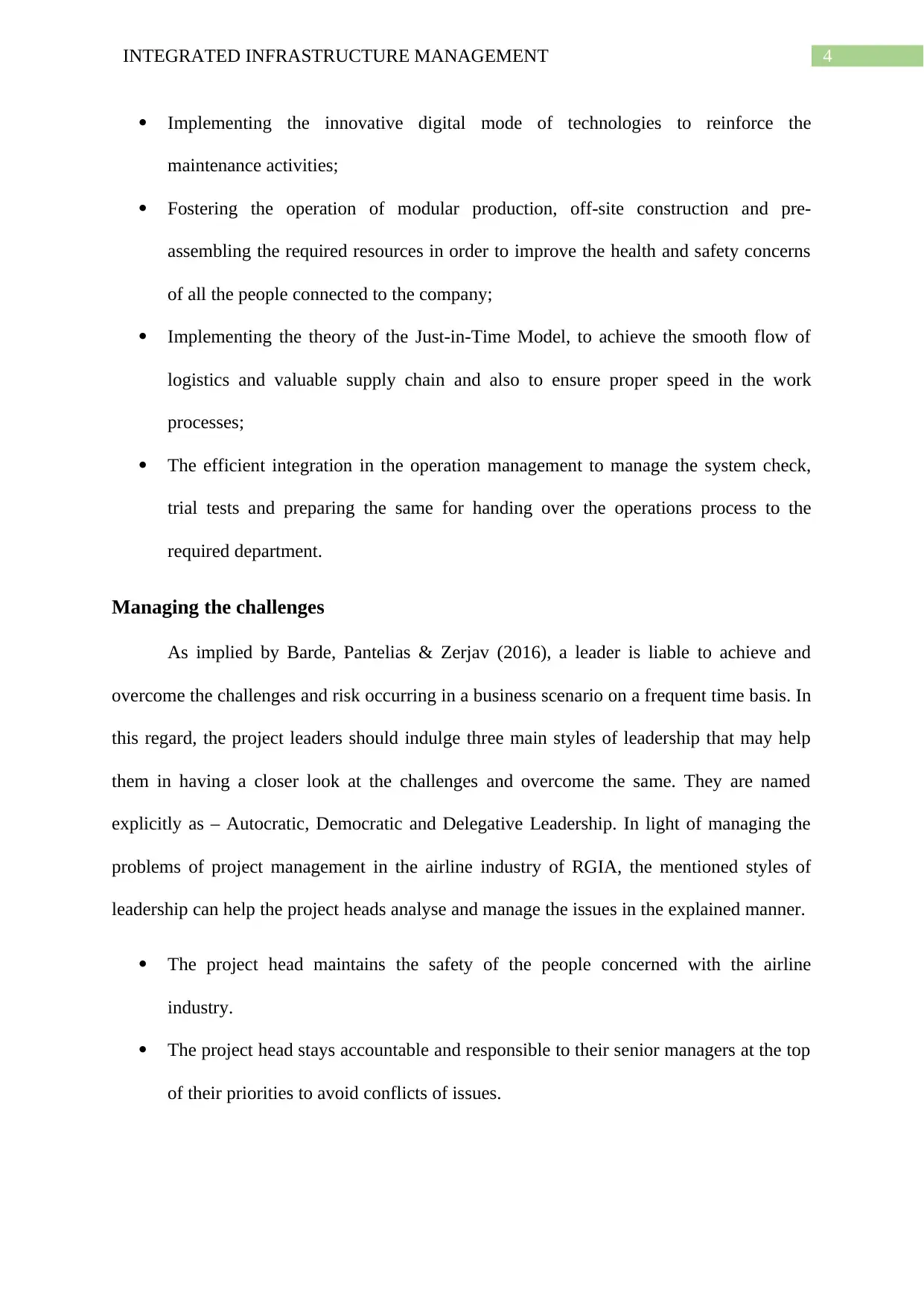
4INTEGRATED INFRASTRUCTURE MANAGEMENT
Implementing the innovative digital mode of technologies to reinforce the
maintenance activities;
Fostering the operation of modular production, off-site construction and pre-
assembling the required resources in order to improve the health and safety concerns
of all the people connected to the company;
Implementing the theory of the Just-in-Time Model, to achieve the smooth flow of
logistics and valuable supply chain and also to ensure proper speed in the work
processes;
The efficient integration in the operation management to manage the system check,
trial tests and preparing the same for handing over the operations process to the
required department.
Managing the challenges
As implied by Barde, Pantelias & Zerjav (2016), a leader is liable to achieve and
overcome the challenges and risk occurring in a business scenario on a frequent time basis. In
this regard, the project leaders should indulge three main styles of leadership that may help
them in having a closer look at the challenges and overcome the same. They are named
explicitly as – Autocratic, Democratic and Delegative Leadership. In light of managing the
problems of project management in the airline industry of RGIA, the mentioned styles of
leadership can help the project heads analyse and manage the issues in the explained manner.
The project head maintains the safety of the people concerned with the airline
industry.
The project head stays accountable and responsible to their senior managers at the top
of their priorities to avoid conflicts of issues.
Implementing the innovative digital mode of technologies to reinforce the
maintenance activities;
Fostering the operation of modular production, off-site construction and pre-
assembling the required resources in order to improve the health and safety concerns
of all the people connected to the company;
Implementing the theory of the Just-in-Time Model, to achieve the smooth flow of
logistics and valuable supply chain and also to ensure proper speed in the work
processes;
The efficient integration in the operation management to manage the system check,
trial tests and preparing the same for handing over the operations process to the
required department.
Managing the challenges
As implied by Barde, Pantelias & Zerjav (2016), a leader is liable to achieve and
overcome the challenges and risk occurring in a business scenario on a frequent time basis. In
this regard, the project leaders should indulge three main styles of leadership that may help
them in having a closer look at the challenges and overcome the same. They are named
explicitly as – Autocratic, Democratic and Delegative Leadership. In light of managing the
problems of project management in the airline industry of RGIA, the mentioned styles of
leadership can help the project heads analyse and manage the issues in the explained manner.
The project head maintains the safety of the people concerned with the airline
industry.
The project head stays accountable and responsible to their senior managers at the top
of their priorities to avoid conflicts of issues.
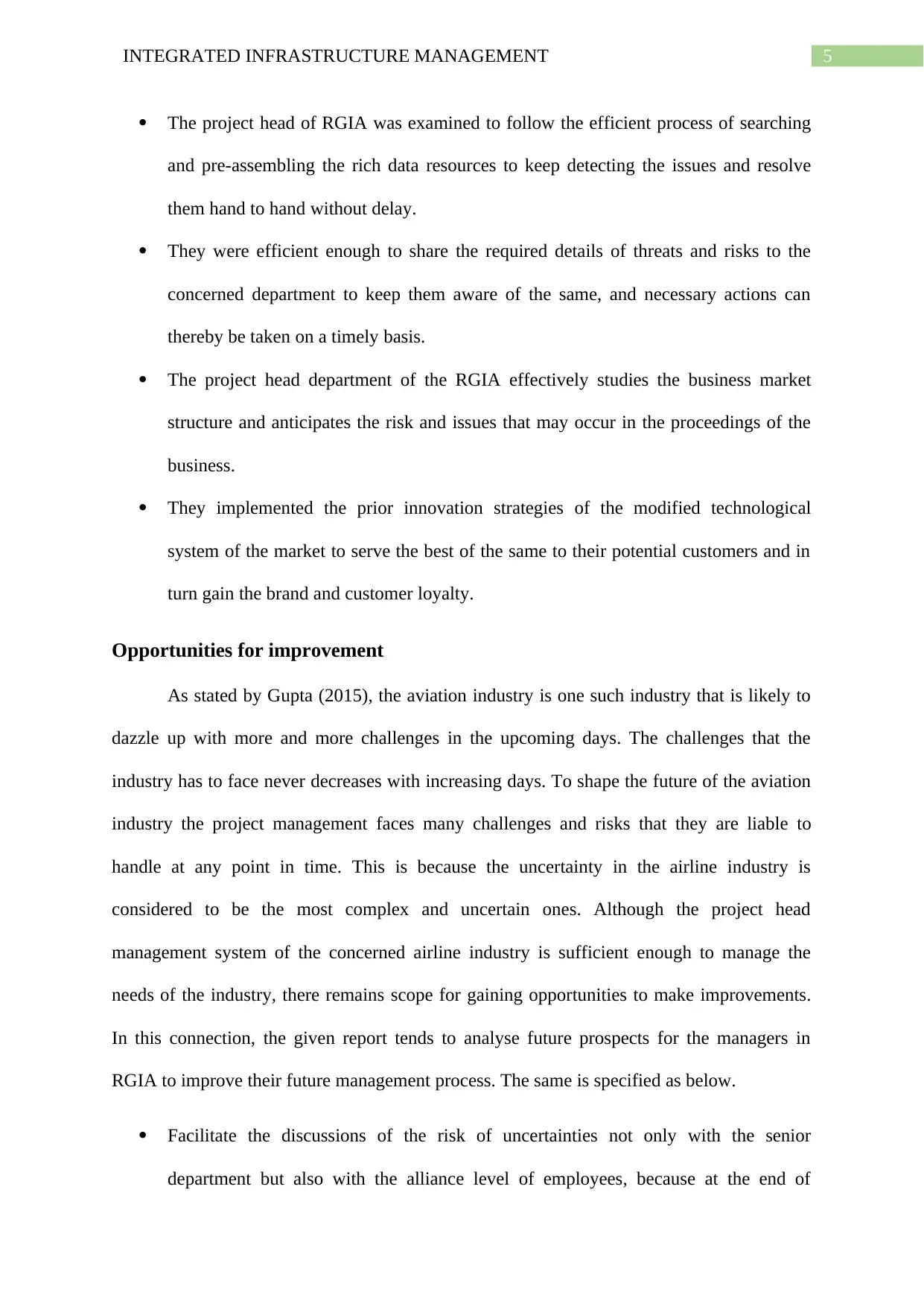
5INTEGRATED INFRASTRUCTURE MANAGEMENT
The project head of RGIA was examined to follow the efficient process of searching
and pre-assembling the rich data resources to keep detecting the issues and resolve
them hand to hand without delay.
They were efficient enough to share the required details of threats and risks to the
concerned department to keep them aware of the same, and necessary actions can
thereby be taken on a timely basis.
The project head department of the RGIA effectively studies the business market
structure and anticipates the risk and issues that may occur in the proceedings of the
business.
They implemented the prior innovation strategies of the modified technological
system of the market to serve the best of the same to their potential customers and in
turn gain the brand and customer loyalty.
Opportunities for improvement
As stated by Gupta (2015), the aviation industry is one such industry that is likely to
dazzle up with more and more challenges in the upcoming days. The challenges that the
industry has to face never decreases with increasing days. To shape the future of the aviation
industry the project management faces many challenges and risks that they are liable to
handle at any point in time. This is because the uncertainty in the airline industry is
considered to be the most complex and uncertain ones. Although the project head
management system of the concerned airline industry is sufficient enough to manage the
needs of the industry, there remains scope for gaining opportunities to make improvements.
In this connection, the given report tends to analyse future prospects for the managers in
RGIA to improve their future management process. The same is specified as below.
Facilitate the discussions of the risk of uncertainties not only with the senior
department but also with the alliance level of employees, because at the end of
The project head of RGIA was examined to follow the efficient process of searching
and pre-assembling the rich data resources to keep detecting the issues and resolve
them hand to hand without delay.
They were efficient enough to share the required details of threats and risks to the
concerned department to keep them aware of the same, and necessary actions can
thereby be taken on a timely basis.
The project head department of the RGIA effectively studies the business market
structure and anticipates the risk and issues that may occur in the proceedings of the
business.
They implemented the prior innovation strategies of the modified technological
system of the market to serve the best of the same to their potential customers and in
turn gain the brand and customer loyalty.
Opportunities for improvement
As stated by Gupta (2015), the aviation industry is one such industry that is likely to
dazzle up with more and more challenges in the upcoming days. The challenges that the
industry has to face never decreases with increasing days. To shape the future of the aviation
industry the project management faces many challenges and risks that they are liable to
handle at any point in time. This is because the uncertainty in the airline industry is
considered to be the most complex and uncertain ones. Although the project head
management system of the concerned airline industry is sufficient enough to manage the
needs of the industry, there remains scope for gaining opportunities to make improvements.
In this connection, the given report tends to analyse future prospects for the managers in
RGIA to improve their future management process. The same is specified as below.
Facilitate the discussions of the risk of uncertainties not only with the senior
department but also with the alliance level of employees, because at the end of
⊘ This is a preview!⊘
Do you want full access?
Subscribe today to unlock all pages.

Trusted by 1+ million students worldwide
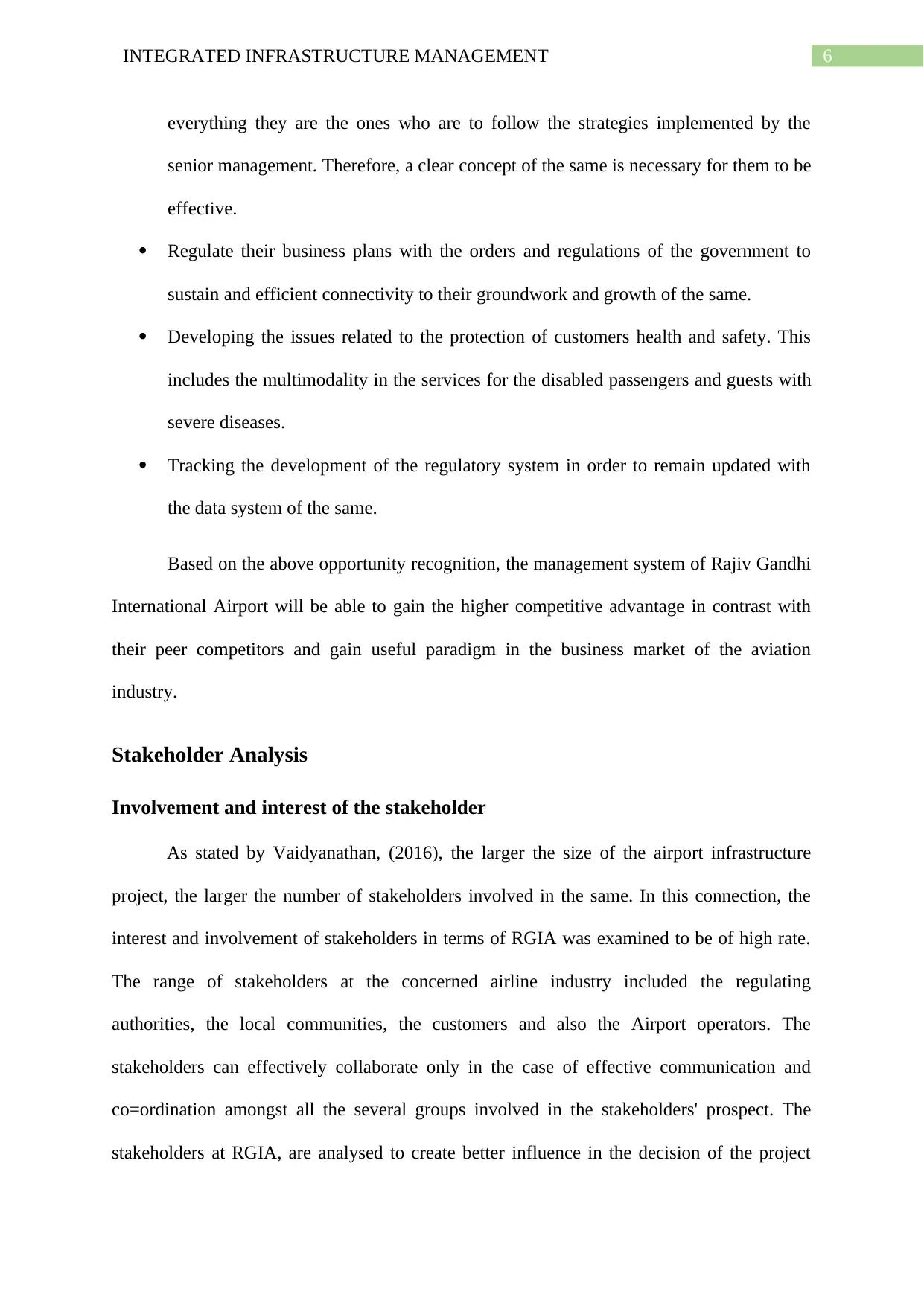
6INTEGRATED INFRASTRUCTURE MANAGEMENT
everything they are the ones who are to follow the strategies implemented by the
senior management. Therefore, a clear concept of the same is necessary for them to be
effective.
Regulate their business plans with the orders and regulations of the government to
sustain and efficient connectivity to their groundwork and growth of the same.
Developing the issues related to the protection of customers health and safety. This
includes the multimodality in the services for the disabled passengers and guests with
severe diseases.
Tracking the development of the regulatory system in order to remain updated with
the data system of the same.
Based on the above opportunity recognition, the management system of Rajiv Gandhi
International Airport will be able to gain the higher competitive advantage in contrast with
their peer competitors and gain useful paradigm in the business market of the aviation
industry.
Stakeholder Analysis
Involvement and interest of the stakeholder
As stated by Vaidyanathan, (2016), the larger the size of the airport infrastructure
project, the larger the number of stakeholders involved in the same. In this connection, the
interest and involvement of stakeholders in terms of RGIA was examined to be of high rate.
The range of stakeholders at the concerned airline industry included the regulating
authorities, the local communities, the customers and also the Airport operators. The
stakeholders can effectively collaborate only in the case of effective communication and
co=ordination amongst all the several groups involved in the stakeholders' prospect. The
stakeholders at RGIA, are analysed to create better influence in the decision of the project
everything they are the ones who are to follow the strategies implemented by the
senior management. Therefore, a clear concept of the same is necessary for them to be
effective.
Regulate their business plans with the orders and regulations of the government to
sustain and efficient connectivity to their groundwork and growth of the same.
Developing the issues related to the protection of customers health and safety. This
includes the multimodality in the services for the disabled passengers and guests with
severe diseases.
Tracking the development of the regulatory system in order to remain updated with
the data system of the same.
Based on the above opportunity recognition, the management system of Rajiv Gandhi
International Airport will be able to gain the higher competitive advantage in contrast with
their peer competitors and gain useful paradigm in the business market of the aviation
industry.
Stakeholder Analysis
Involvement and interest of the stakeholder
As stated by Vaidyanathan, (2016), the larger the size of the airport infrastructure
project, the larger the number of stakeholders involved in the same. In this connection, the
interest and involvement of stakeholders in terms of RGIA was examined to be of high rate.
The range of stakeholders at the concerned airline industry included the regulating
authorities, the local communities, the customers and also the Airport operators. The
stakeholders can effectively collaborate only in the case of effective communication and
co=ordination amongst all the several groups involved in the stakeholders' prospect. The
stakeholders at RGIA, are analysed to create better influence in the decision of the project
Paraphrase This Document
Need a fresh take? Get an instant paraphrase of this document with our AI Paraphraser
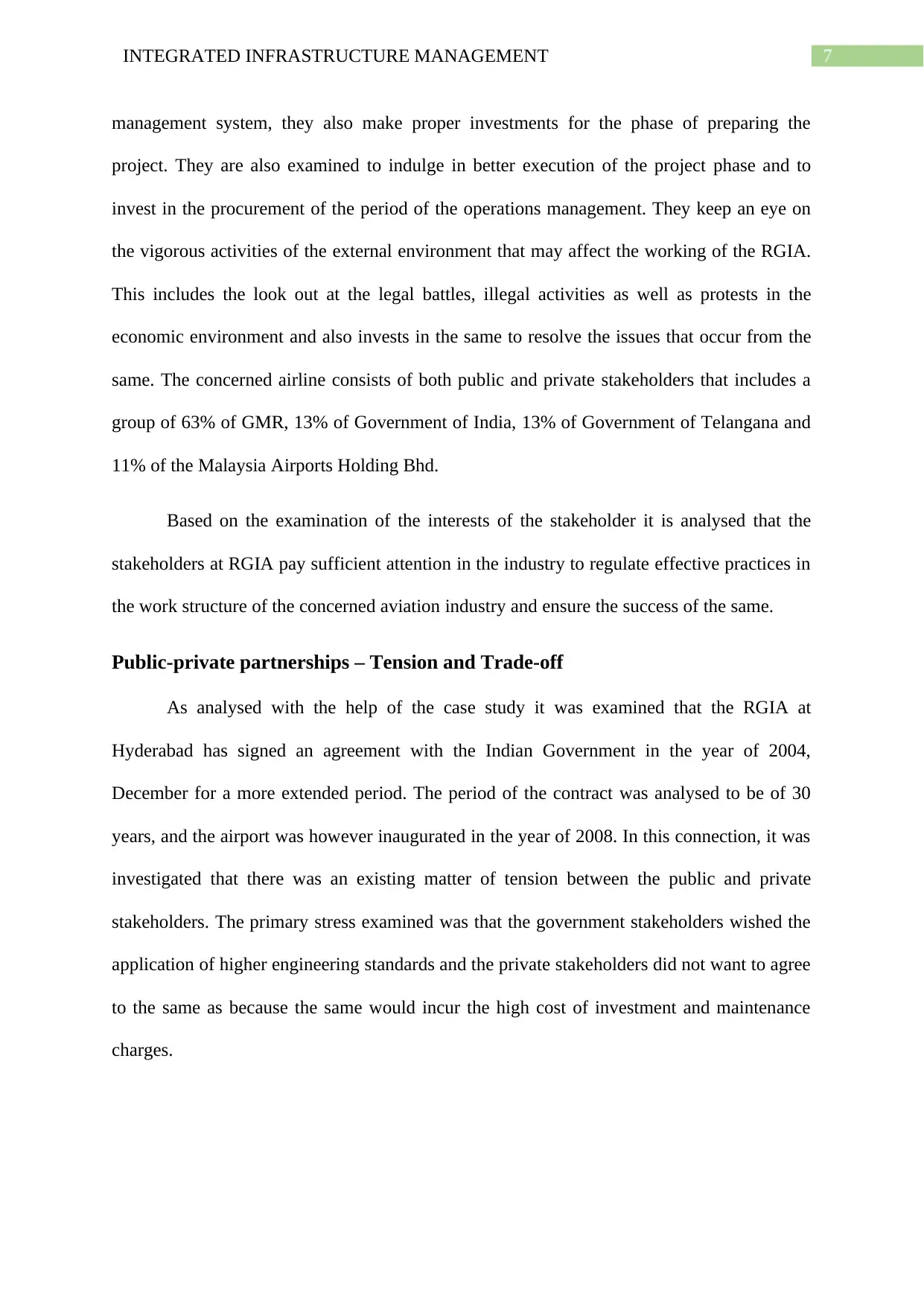
7INTEGRATED INFRASTRUCTURE MANAGEMENT
management system, they also make proper investments for the phase of preparing the
project. They are also examined to indulge in better execution of the project phase and to
invest in the procurement of the period of the operations management. They keep an eye on
the vigorous activities of the external environment that may affect the working of the RGIA.
This includes the look out at the legal battles, illegal activities as well as protests in the
economic environment and also invests in the same to resolve the issues that occur from the
same. The concerned airline consists of both public and private stakeholders that includes a
group of 63% of GMR, 13% of Government of India, 13% of Government of Telangana and
11% of the Malaysia Airports Holding Bhd.
Based on the examination of the interests of the stakeholder it is analysed that the
stakeholders at RGIA pay sufficient attention in the industry to regulate effective practices in
the work structure of the concerned aviation industry and ensure the success of the same.
Public-private partnerships – Tension and Trade-off
As analysed with the help of the case study it was examined that the RGIA at
Hyderabad has signed an agreement with the Indian Government in the year of 2004,
December for a more extended period. The period of the contract was analysed to be of 30
years, and the airport was however inaugurated in the year of 2008. In this connection, it was
investigated that there was an existing matter of tension between the public and private
stakeholders. The primary stress examined was that the government stakeholders wished the
application of higher engineering standards and the private stakeholders did not want to agree
to the same as because the same would incur the high cost of investment and maintenance
charges.
management system, they also make proper investments for the phase of preparing the
project. They are also examined to indulge in better execution of the project phase and to
invest in the procurement of the period of the operations management. They keep an eye on
the vigorous activities of the external environment that may affect the working of the RGIA.
This includes the look out at the legal battles, illegal activities as well as protests in the
economic environment and also invests in the same to resolve the issues that occur from the
same. The concerned airline consists of both public and private stakeholders that includes a
group of 63% of GMR, 13% of Government of India, 13% of Government of Telangana and
11% of the Malaysia Airports Holding Bhd.
Based on the examination of the interests of the stakeholder it is analysed that the
stakeholders at RGIA pay sufficient attention in the industry to regulate effective practices in
the work structure of the concerned aviation industry and ensure the success of the same.
Public-private partnerships – Tension and Trade-off
As analysed with the help of the case study it was examined that the RGIA at
Hyderabad has signed an agreement with the Indian Government in the year of 2004,
December for a more extended period. The period of the contract was analysed to be of 30
years, and the airport was however inaugurated in the year of 2008. In this connection, it was
investigated that there was an existing matter of tension between the public and private
stakeholders. The primary stress examined was that the government stakeholders wished the
application of higher engineering standards and the private stakeholders did not want to agree
to the same as because the same would incur the high cost of investment and maintenance
charges.
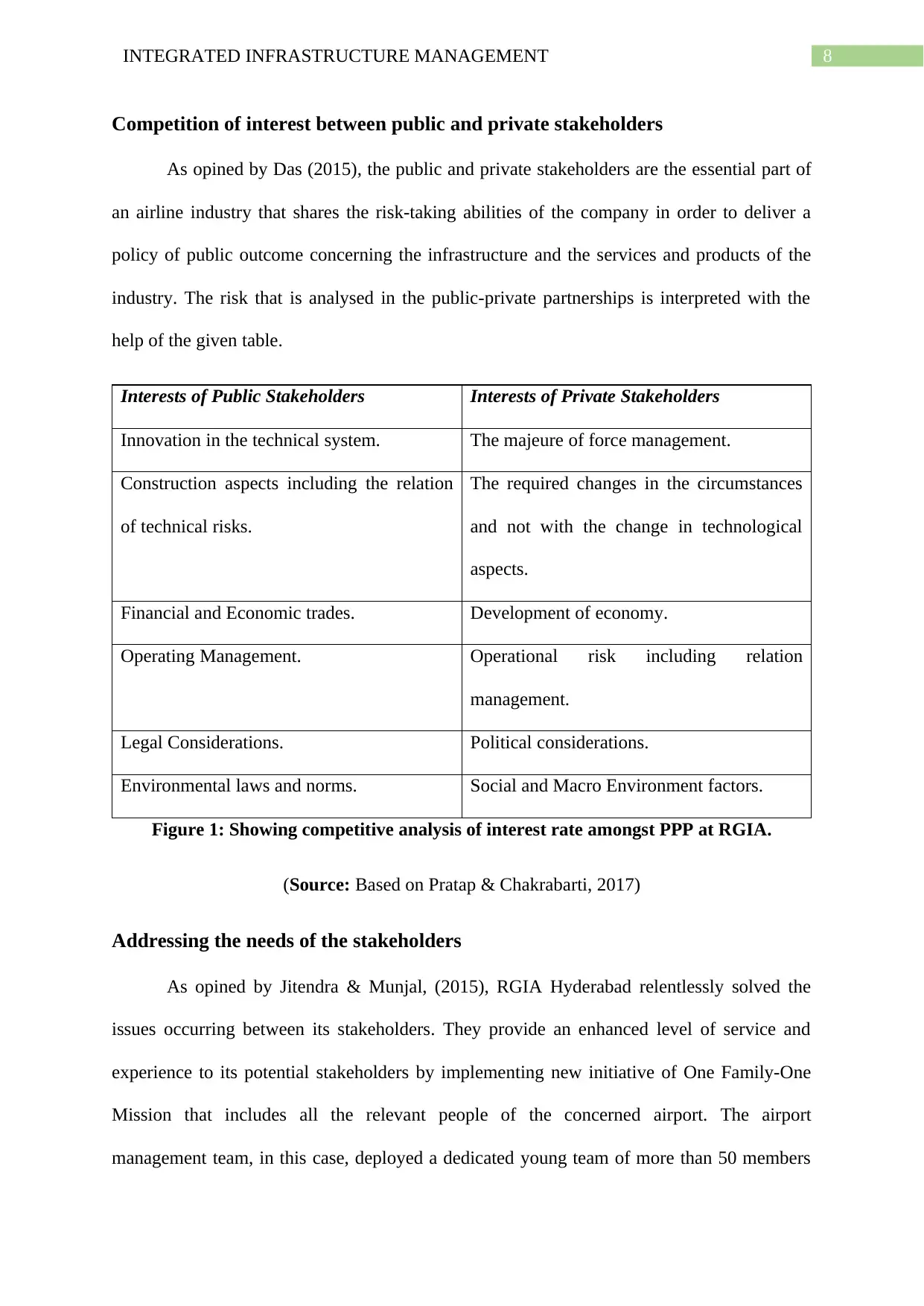
8INTEGRATED INFRASTRUCTURE MANAGEMENT
Competition of interest between public and private stakeholders
As opined by Das (2015), the public and private stakeholders are the essential part of
an airline industry that shares the risk-taking abilities of the company in order to deliver a
policy of public outcome concerning the infrastructure and the services and products of the
industry. The risk that is analysed in the public-private partnerships is interpreted with the
help of the given table.
Interests of Public Stakeholders Interests of Private Stakeholders
Innovation in the technical system. The majeure of force management.
Construction aspects including the relation
of technical risks.
The required changes in the circumstances
and not with the change in technological
aspects.
Financial and Economic trades. Development of economy.
Operating Management. Operational risk including relation
management.
Legal Considerations. Political considerations.
Environmental laws and norms. Social and Macro Environment factors.
Figure 1: Showing competitive analysis of interest rate amongst PPP at RGIA.
(Source: Based on Pratap & Chakrabarti, 2017)
Addressing the needs of the stakeholders
As opined by Jitendra & Munjal, (2015), RGIA Hyderabad relentlessly solved the
issues occurring between its stakeholders. They provide an enhanced level of service and
experience to its potential stakeholders by implementing new initiative of One Family-One
Mission that includes all the relevant people of the concerned airport. The airport
management team, in this case, deployed a dedicated young team of more than 50 members
Competition of interest between public and private stakeholders
As opined by Das (2015), the public and private stakeholders are the essential part of
an airline industry that shares the risk-taking abilities of the company in order to deliver a
policy of public outcome concerning the infrastructure and the services and products of the
industry. The risk that is analysed in the public-private partnerships is interpreted with the
help of the given table.
Interests of Public Stakeholders Interests of Private Stakeholders
Innovation in the technical system. The majeure of force management.
Construction aspects including the relation
of technical risks.
The required changes in the circumstances
and not with the change in technological
aspects.
Financial and Economic trades. Development of economy.
Operating Management. Operational risk including relation
management.
Legal Considerations. Political considerations.
Environmental laws and norms. Social and Macro Environment factors.
Figure 1: Showing competitive analysis of interest rate amongst PPP at RGIA.
(Source: Based on Pratap & Chakrabarti, 2017)
Addressing the needs of the stakeholders
As opined by Jitendra & Munjal, (2015), RGIA Hyderabad relentlessly solved the
issues occurring between its stakeholders. They provide an enhanced level of service and
experience to its potential stakeholders by implementing new initiative of One Family-One
Mission that includes all the relevant people of the concerned airport. The airport
management team, in this case, deployed a dedicated young team of more than 50 members
⊘ This is a preview!⊘
Do you want full access?
Subscribe today to unlock all pages.

Trusted by 1+ million students worldwide
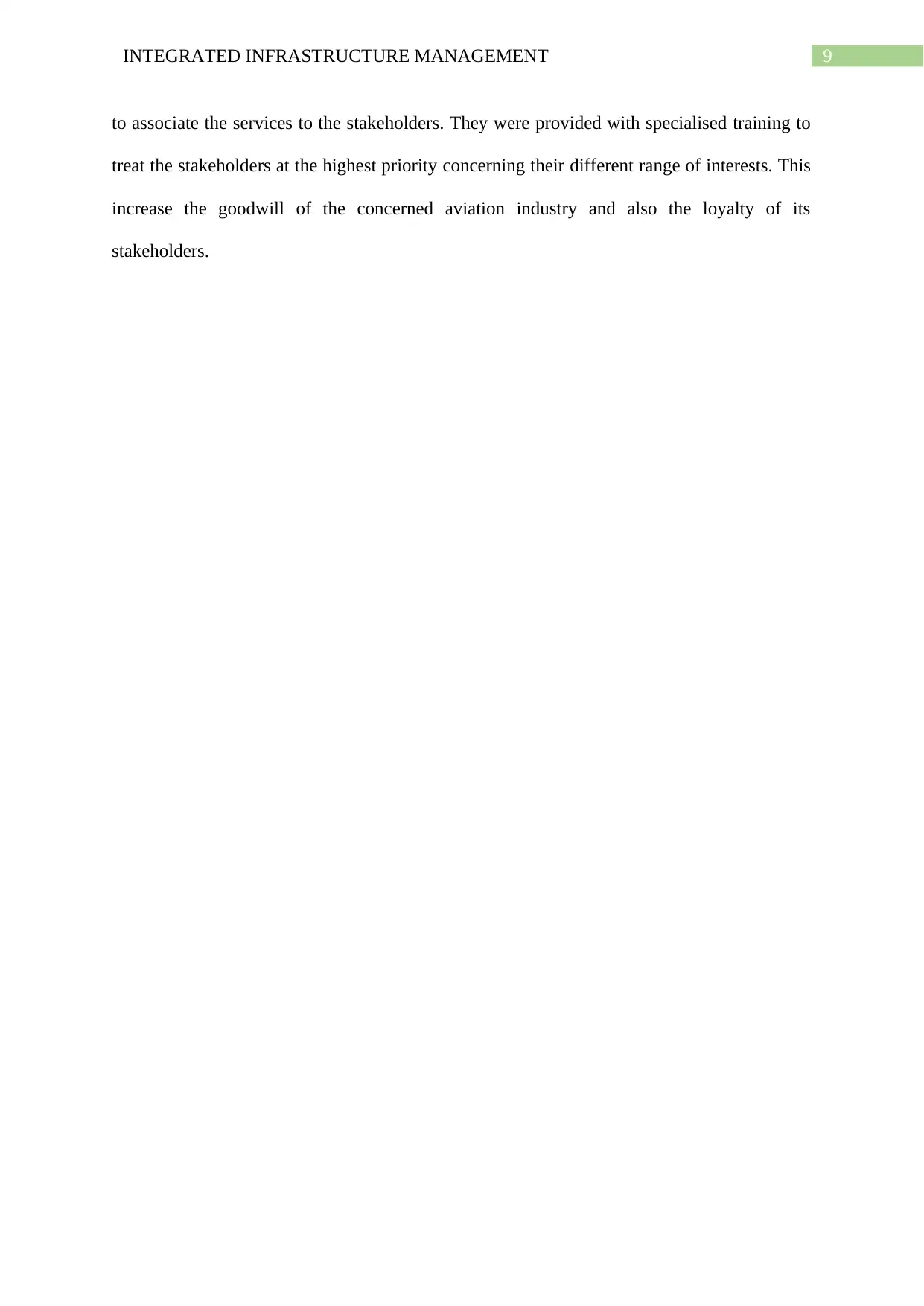
9INTEGRATED INFRASTRUCTURE MANAGEMENT
to associate the services to the stakeholders. They were provided with specialised training to
treat the stakeholders at the highest priority concerning their different range of interests. This
increase the goodwill of the concerned aviation industry and also the loyalty of its
stakeholders.
to associate the services to the stakeholders. They were provided with specialised training to
treat the stakeholders at the highest priority concerning their different range of interests. This
increase the goodwill of the concerned aviation industry and also the loyalty of its
stakeholders.
Paraphrase This Document
Need a fresh take? Get an instant paraphrase of this document with our AI Paraphraser
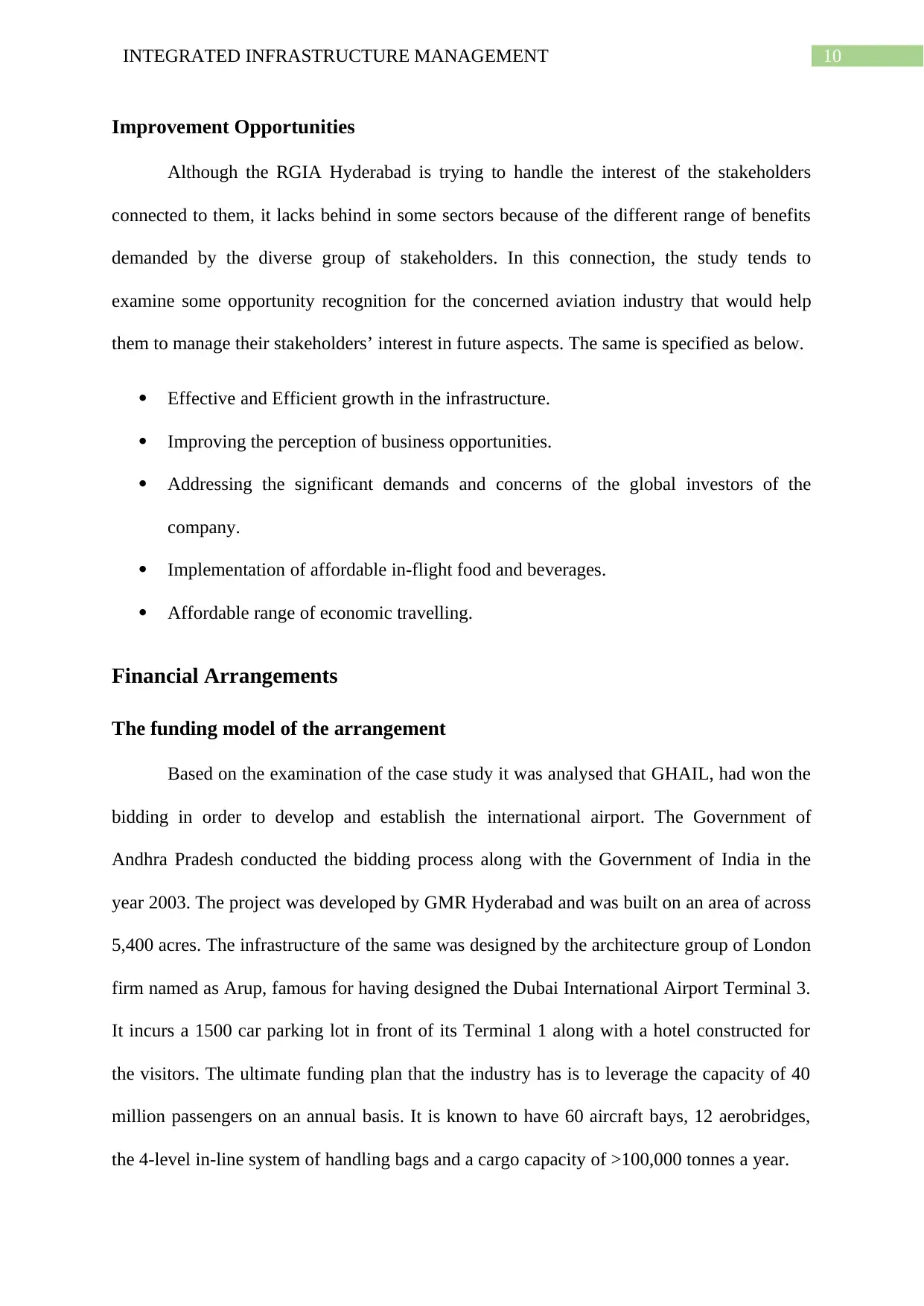
10INTEGRATED INFRASTRUCTURE MANAGEMENT
Improvement Opportunities
Although the RGIA Hyderabad is trying to handle the interest of the stakeholders
connected to them, it lacks behind in some sectors because of the different range of benefits
demanded by the diverse group of stakeholders. In this connection, the study tends to
examine some opportunity recognition for the concerned aviation industry that would help
them to manage their stakeholders’ interest in future aspects. The same is specified as below.
Effective and Efficient growth in the infrastructure.
Improving the perception of business opportunities.
Addressing the significant demands and concerns of the global investors of the
company.
Implementation of affordable in-flight food and beverages.
Affordable range of economic travelling.
Financial Arrangements
The funding model of the arrangement
Based on the examination of the case study it was analysed that GHAIL, had won the
bidding in order to develop and establish the international airport. The Government of
Andhra Pradesh conducted the bidding process along with the Government of India in the
year 2003. The project was developed by GMR Hyderabad and was built on an area of across
5,400 acres. The infrastructure of the same was designed by the architecture group of London
firm named as Arup, famous for having designed the Dubai International Airport Terminal 3.
It incurs a 1500 car parking lot in front of its Terminal 1 along with a hotel constructed for
the visitors. The ultimate funding plan that the industry has is to leverage the capacity of 40
million passengers on an annual basis. It is known to have 60 aircraft bays, 12 aerobridges,
the 4-level in-line system of handling bags and a cargo capacity of >100,000 tonnes a year.
Improvement Opportunities
Although the RGIA Hyderabad is trying to handle the interest of the stakeholders
connected to them, it lacks behind in some sectors because of the different range of benefits
demanded by the diverse group of stakeholders. In this connection, the study tends to
examine some opportunity recognition for the concerned aviation industry that would help
them to manage their stakeholders’ interest in future aspects. The same is specified as below.
Effective and Efficient growth in the infrastructure.
Improving the perception of business opportunities.
Addressing the significant demands and concerns of the global investors of the
company.
Implementation of affordable in-flight food and beverages.
Affordable range of economic travelling.
Financial Arrangements
The funding model of the arrangement
Based on the examination of the case study it was analysed that GHAIL, had won the
bidding in order to develop and establish the international airport. The Government of
Andhra Pradesh conducted the bidding process along with the Government of India in the
year 2003. The project was developed by GMR Hyderabad and was built on an area of across
5,400 acres. The infrastructure of the same was designed by the architecture group of London
firm named as Arup, famous for having designed the Dubai International Airport Terminal 3.
It incurs a 1500 car parking lot in front of its Terminal 1 along with a hotel constructed for
the visitors. The ultimate funding plan that the industry has is to leverage the capacity of 40
million passengers on an annual basis. It is known to have 60 aircraft bays, 12 aerobridges,
the 4-level in-line system of handling bags and a cargo capacity of >100,000 tonnes a year.
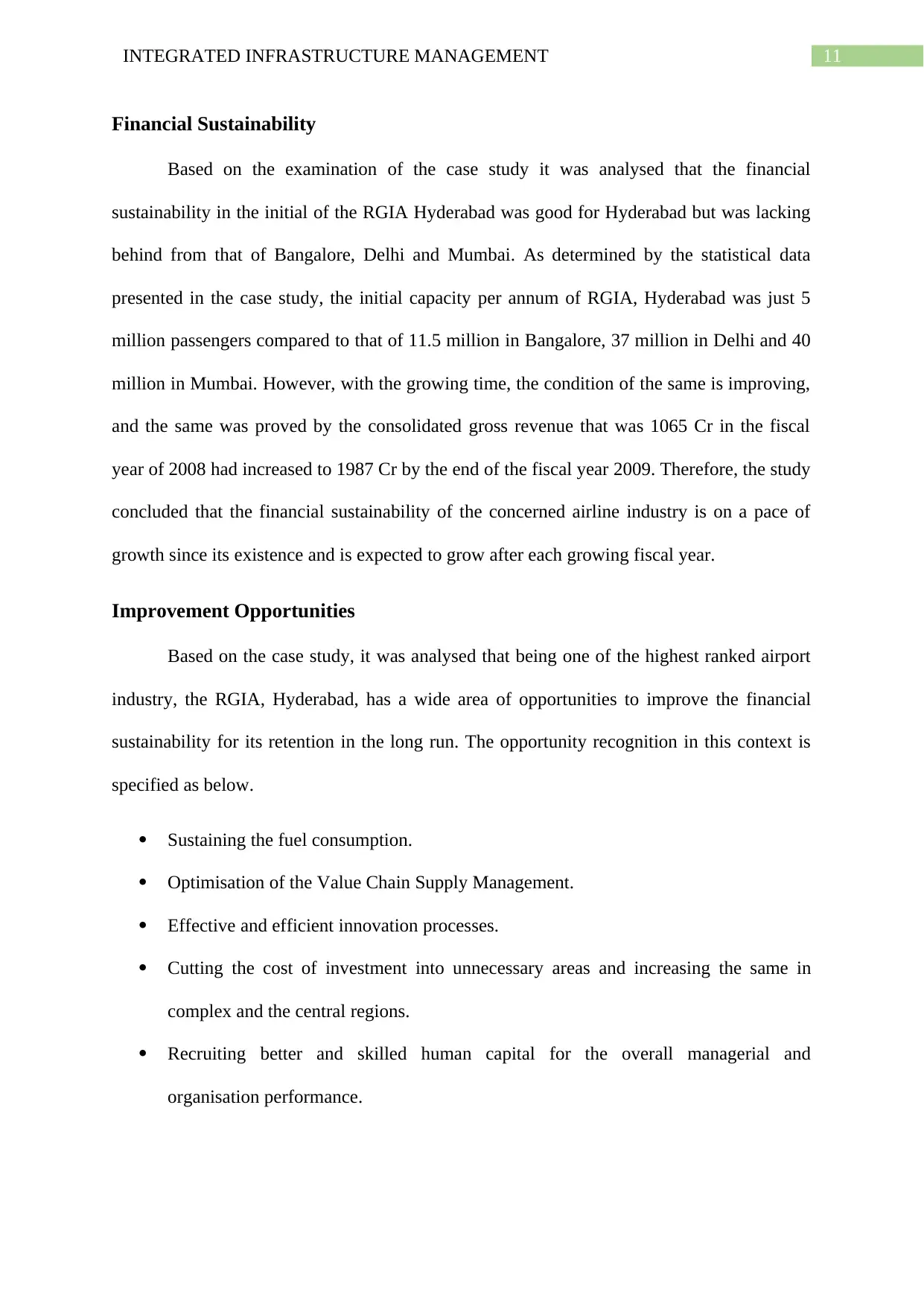
11INTEGRATED INFRASTRUCTURE MANAGEMENT
Financial Sustainability
Based on the examination of the case study it was analysed that the financial
sustainability in the initial of the RGIA Hyderabad was good for Hyderabad but was lacking
behind from that of Bangalore, Delhi and Mumbai. As determined by the statistical data
presented in the case study, the initial capacity per annum of RGIA, Hyderabad was just 5
million passengers compared to that of 11.5 million in Bangalore, 37 million in Delhi and 40
million in Mumbai. However, with the growing time, the condition of the same is improving,
and the same was proved by the consolidated gross revenue that was 1065 Cr in the fiscal
year of 2008 had increased to 1987 Cr by the end of the fiscal year 2009. Therefore, the study
concluded that the financial sustainability of the concerned airline industry is on a pace of
growth since its existence and is expected to grow after each growing fiscal year.
Improvement Opportunities
Based on the case study, it was analysed that being one of the highest ranked airport
industry, the RGIA, Hyderabad, has a wide area of opportunities to improve the financial
sustainability for its retention in the long run. The opportunity recognition in this context is
specified as below.
Sustaining the fuel consumption.
Optimisation of the Value Chain Supply Management.
Effective and efficient innovation processes.
Cutting the cost of investment into unnecessary areas and increasing the same in
complex and the central regions.
Recruiting better and skilled human capital for the overall managerial and
organisation performance.
Financial Sustainability
Based on the examination of the case study it was analysed that the financial
sustainability in the initial of the RGIA Hyderabad was good for Hyderabad but was lacking
behind from that of Bangalore, Delhi and Mumbai. As determined by the statistical data
presented in the case study, the initial capacity per annum of RGIA, Hyderabad was just 5
million passengers compared to that of 11.5 million in Bangalore, 37 million in Delhi and 40
million in Mumbai. However, with the growing time, the condition of the same is improving,
and the same was proved by the consolidated gross revenue that was 1065 Cr in the fiscal
year of 2008 had increased to 1987 Cr by the end of the fiscal year 2009. Therefore, the study
concluded that the financial sustainability of the concerned airline industry is on a pace of
growth since its existence and is expected to grow after each growing fiscal year.
Improvement Opportunities
Based on the case study, it was analysed that being one of the highest ranked airport
industry, the RGIA, Hyderabad, has a wide area of opportunities to improve the financial
sustainability for its retention in the long run. The opportunity recognition in this context is
specified as below.
Sustaining the fuel consumption.
Optimisation of the Value Chain Supply Management.
Effective and efficient innovation processes.
Cutting the cost of investment into unnecessary areas and increasing the same in
complex and the central regions.
Recruiting better and skilled human capital for the overall managerial and
organisation performance.
⊘ This is a preview!⊘
Do you want full access?
Subscribe today to unlock all pages.

Trusted by 1+ million students worldwide
1 out of 17
Related Documents
Your All-in-One AI-Powered Toolkit for Academic Success.
+13062052269
info@desklib.com
Available 24*7 on WhatsApp / Email
![[object Object]](/_next/static/media/star-bottom.7253800d.svg)
Unlock your academic potential
Copyright © 2020–2025 A2Z Services. All Rights Reserved. Developed and managed by ZUCOL.




